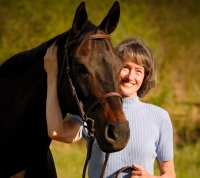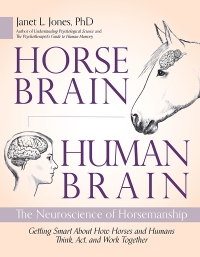TRUE TRAINING 85 - Turnout Turmoil
Turnout is a risky proposition for performance horses: it’s great when everything goes well, but it can lead to serious injuries when there are problems. I insist on it for my own horses, to improve their health and fulfill my ethical responsibilities. One of the top tenets of animal ethics is to allow for basic instincts to be met. That means chickens need to peck, for example, and horses need to move. I’ve written elsewhere about the physical dangers, emotional distress, and ethical violations of long-term stall rest.
Until last year, True spent most of his life living in large pastures 24/7. He had trees for shade, horse buddies nearby, safe fencing, and a three-sided shelter with a raised floor and high roof. It was covered in rubber mats that were cleaned daily. He shared this five-acre grass pasture with one other horse. Additional horses lived within his view, and he could play with geldings over the fences. It was ideal.
Currently, True spends his nights in a very large stall with an outdoor run, but he is turned out during the day with other geldings. Everything has been fine... but you know how our prey animals are: one little change can lead to weeks of trouble. Recently, while I was giving clinics overseas, two new horses arrived. They were turned out in the pasture next to True and his boy band, with a common fence between them. And… um… the two new horses were mares. In heat.
Regular readers know that Truebie is extremely fond of mares (see post 60). His favorite female friend used to stand next to him across the fence while he licked her entire body every day. Every mare is honored with his attention when we work together in an arena. But he has not been around mares in heat, so that part was new. And dangerous.
Most people assume that geldings, especially those who were castrated early in life, do not respond to mares in heat. And a few don’t. But many geldings do respond, physically and emotionally, and many will fight over a nearby mare. These fights involve kicking, biting, striking, and chasing, and they can cause severe injuries or death.
One solution is to separate turnout for mares and geldings with some sort of gap or buffer zone between them. Ideally, I prefer to place the two sexes within sight of each other but with at least a 50-foot distance between the two fences. I introduce new horses very gradually to each other, one at a time, one hour at a time. Then I observe. If everyone remains calm, I proceed to full turnout with the buffer zone intact. It’s safer for everyone – the mares, the geldings, and the human handlers.
Individual differences are strong in turnout behavior—it’s hard to predict what will happen when two horses meet. In this case, placing two mares in heat next to a group of geldings resulted in utter turmoil. The geldings vied for position—who gets to be closest to the mares? They whinnied loudly every few minutes, refused to eat, and ran the fenceline back and forth all day.
Minor turnout problems often resolve after a few days when horses have been introduced gradually. Horses get accustomed to newcomers in other pastures, and soon life goes back to normal. But this time, the mares became excited and the geldings remained frantic. All the horses became difficult to lead to and from turnout, and all lost weight.
After a week, True was still so obsessed he could not look away from the mares’ direction, spinning back to his preferred position while I tried to lead, groom, or ride him. He whinnied in my ear, smacked his hundred-pound head into my face, and stepped on my feet while I was leading him—things that never happen—all in a desperate attempt to keep “his” mares in sight. All accidental, but dangerous nonetheless. Soon it was obvious that riding under these conditions was risky for me and exhausting for him, given his lack of food, so we stopped for a few days.
Within one week after the mares arrived, four of the six turnout horses were injured. True suffered multiple kick wounds and bite marks, a split hoof, surface lacerations on his lower legs, and a swollen fetlock. All are healing, but these injuries were warning signs. Changes had to be made.
Currently, the mares and geldings are turned out separately, one group in the morning and the other in the evening. Regu-mate is being given to the mares to suppress behavioral signs of heat. (By the way, a new method of suppressing heat can be found in the Pearl Pod, an IUD for mares that has been successful in early trials.) When their loading doses are complete, a buffer zone will remain between the turnouts for mares and geldings, and reintroduction should be gradual.
After three days of complete separation (i.e., not even seeing the mares), True is rideable again. He still whinnies to the mares, but only 2-3 times during our sessions and they do not respond. Each day he displays fewer signs of anxiety and will soon be back to normal. When we begin full turnout again, I’ll monitor True’s responses carefully and limit exposure until he is able to build back up to his typical turnout behavior. He has been calm—though highly attentive—with other mares in the past, so I think we can reduce turnout turmoil significantly with thoughtful planning.

